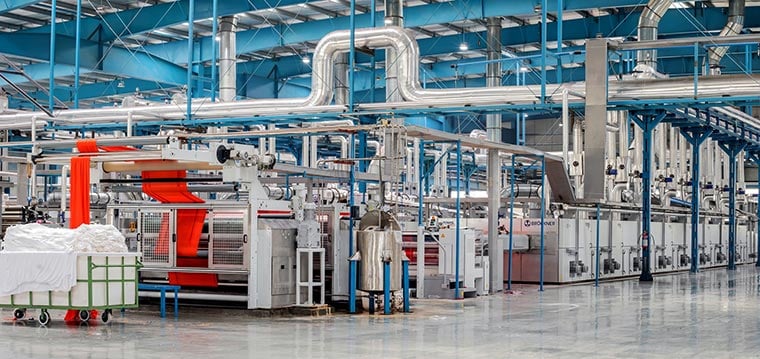
Boosting the sustainability of manufacturing processes
October 2021
By Simon Copley – Mechanical Engineer at 42 Technology

Think about the sustainability of any product, anything from electronic gadgets to food and drink, and you might think about its constituent materials, and almost certainly its packaging, and how easy they are to recycle.
But an important aspect of a product’s sustainability is hidden from the end user because it happens long before a product hits the shelves: the resources used for processing during manufacture. This article outlines a robust process to investigate your manufacturing process and unlock sustainability improvements.
Many manufacturing processes rely on a significant consumption of natural resources such as electricity, gas, and water - not as ingredients/materials that end up as part of the final product, but resources used by the manufacturing process itself. Think of a biscuit factory, and the hidden resource is gas burned during cooking; or in semiconductor manufacture where water usage is surprisingly high. In addition, natural resources are used to process material that ends up discarded as by-product.
Often this resource consumption is critical to maintaining a successful process, but it carries twin disadvantages:
- Environmental impact either from carbon emissions or by-products such as wastewater.
As the world faces the challenge of drastically reducing emissions and consumption of natural resources, manufacturers need to play their part. - Increased operating costs to pay for energy, water, or other consumables.
Many manufacturers have set themselves tough challenges to reduce natural resource consumption, driven by one of the two factors above. The relative importance of each factor depends on the situation in question:
- Environmental driven: The aim is often to reduce resource use as cheaply and quickly as possible, with minimal effect on the bottom line.
This means that any process changes shouldn’t decrease throughput or increase scrap. - Operating cost driven: The benefits of these are simpler to judge, given that cost is easier to account for. The environmental impact is a useful by-product but is a less tangible benefit
For most processes, merely tweaking the process parameters is likely to only yield small improvements. There is a limit to this evolutionary approach, which might have already been reached for mature technologies.
Going the step further to unlock significant savings requires a different mindset. It’s important to approach the problem in a structured manner; understanding the process in detail and analysing where radical rethink or new investment will yield the best results.
Understanding the current process
First you need to know exactly where and how resources are used. It’s important to acknowledge any preconceptions you may have about how your manufacturing process operates, how resources are used, whether any can be reused, and most importantly: what parts of the process can and can’t be changed. Making sure you’re approaching the task with an open mind, otherwise you might overlook good solutions. (See Challenging preconceptions: the importance of understanding what you do and don’t know).
The next step is to work your way through the process from start to end, noting where and crucially how resources are used. For example:
- For electricity: commonly used for heating and cooling, and motion/transport such as pumping liquids
- For gas: used for inexpensive, high-power heating
- For water: used for a wide variety of purposes, e.g. adding, removing, or transferring heat, washing ingredients or equipment, dilution of chemicals, and for ease of transporting solids in pipes
- For air: In some cases where expense is incurred to control air temperature/humidity, air can be considered a natural resource
Be wary that when reviewing each process step, ideas for obvious process changes might jump out. While these might be a great local solution, thinking at the system level might uncover the opportunity for even more impressive gains. An obvious example of this would be if a process requires heating at one stage and cooling at another, then rather than optimising each stage in isolation, a heat exchanger linking the two could achieve greater impact.
To avoid missing these system level gains, especially for areas such as heating and cooling, construct a flow diagram of the entire process to show the resource flows at each process step. For resources like water or controlled air, this diagram makes a great diving board for inspiring powerful ideas such as rerouting flows of waste air/water to other process steps where requirements are looser.
Understanding how resources are used
It may appear obvious how a resource is used, but if you overlook any secondary functions then you risk unanticipated consequences with any work to reduce resource consumption.
Two examples of ‘dual purpose’ resources we have experienced are:
Gas – for heat and humidity
If you’re using gas for direct heating within an enclosed setting, remember that the combustion will add water vapour to the surrounding air. If you solve the heating problem (such as by installing electrical heating elements) then you should verify the impact that lower humidity air will have and increase it if needed.
This may be especially important in food production, such as where baked goods are cooked in open moulds over flames.
Water – for washing and thermal transfer
If water is used to washing ingredients by removing contaminants, it will also act as heat exchanger, heating or cooling the ingredients as the water flows past. It may be easy to miss that you’re currently relying on this action to get ingredients to a suitable temperature for a downstream process step.
So, if you manage to somehow make cleaning more efficient, you’ll also need to make sure that the rest of your process can tolerate colder/hotter ingredients, otherwise you may have to add more water back in to fix the process.
Generating ideas
Once you understand the resource use throughout your process, you will be able to build up a menu of ideas with a range of potential savings. Initial analysis or lab testing will let you assign estimates for costs and benefits to each of these.
Your list is likely to range from cheap, simple optimisations (e.g. adding insulation and reducing heating power) to more complex redesigns (e.g. upgrading the least efficient part of the process), or complete system changes (e.g. linking separate process steps to reuse waste heat or water).
Selecting the best ideas for genuine savings
Few improvement initiatives can be made without securing budget or buy-in from within the business. A sensible development plan is crucial to getting this buy-in, including an estimation of the risks of the leading ideas, and how they will benefit the manufacturer’s sustainability objectives (of either reducing operating costs or environmental impact).
Selecting the best ideas for further development doesn’t necessarily mean selecting the ideas with the highest potential resource savings; these might be risky with obstacles obvious to the team. Instead, less risky ‘lower hanging fruit’ ideas might be the best way to go. It all depends on the specific circumstances.
The steps in this article won’t take you all the way towards your sustainability goals but following this systematic process from the start will put you in the best place to make changes and unlock genuine sustainability improvements.

If you would like to find out more please contact Simon:
simon.copley@42T.com | +44 (0)1480 302700 | www.linkedin.com/in/simoncopley
Simon is a highly practical mechanical engineer with a multidisciplinary technical background. While at 42 Technology he has used his skills in projects as varied as designing assembly jigs to reduce the manufacturing cost of an industrial communications device, developing tests to assess the durability of a surgical device, and evaluating the strength of IP held by a large manufacturer of consumer products.
Share this article:
Related Articles

Consumer, Sustainability
The refillable revolution - the sustainable future of grocery shopping

Sustainability, Industrial
The surge in the global Blue Economy - what role for deep tech?

Manufacturing & Automation, Industrial
How to bring sensing in manufacturing out of the lab and onto the line

What will you ask us today?
We believe in asking the right questions to drive innovation; when we know the right questions, we generate the ideas to answer them.

